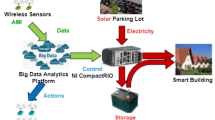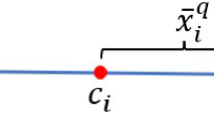Abstract
The ability to accurately estimate energy consumption in the medium and long term based on actual indications is critical for countries to plan and prioritize their futures and take the appropriate actions. This paper proposes a new modified artificial bee colony (M-ABC) method that can adaptively select an optimal search equation to more accurately estimate Turkey’s energy consumption. In the study, linear (M-ABCL) and quadratic (M-ABCQ) mathematical models were developed, and gross domestic product (GDP), population, import, and export data were used as input parameters for energy demand estimation. The weight values in the regression models are calculated according to the objective function with the proposed M-ABC. In this way, the weight values that will produce estimations with the lowest error according to the selected years are found, and then the most appropriate energy demand estimations are made. We compared the performance of our proposed M-ABC algorithm with ant colony optimization (ACO), particle swarm optimization (PSO), and hybrid ACO and PSO (HAP) algorithms. In addition, various estimation suggestions are presented under four different scenarios using input parameters. According to the results, the models suggested with the M-ABC algorithm were more successful in estimating the energy demand. According to the results of the presented four scenarios, the energy demand in 2025 is 145.26, 139.85, 126.26, and 144.17 million tons of oil equivalent (Mtoe) for the M-ABCL model, and 185.62, 161.94, 118.96, and 159.71 Mtoe for the M-ABCQ model, respectively. Thus, it is predicted that average consumption will increase by 51.65% in the linear model and 70.94% in the quadratic model.









Similar content being viewed by others
References
Daus YV, Yudaev IV, Stepanchuk GV (2018) Reducing the costs of paying for consumed electric energy by utilizing solar energy. Appl Sol Energy 54:139–143
Ozcan B, Tzeremes PG, Tzeremes NG (2020) Energy consumption, economic growth and environmental degradation in OECD countries. Econ Model 84:203–213
Sharif A, Baris-Tuzemen O, Uzuner G et al (2020) Revisiting the role of renewable and non-renewable energy consumption on turkey’s ecological footprint: evidence from quantile ARDL approach. Sustain Cities Soc 57:102138
(2020) Organisation for Economic Co-operation and Development -OECD. In: Organ. Econ. Co-operation Dev. https://www.oecd.org/
Balat M (2010) Security of energy supply in Turkey: challenges and solutions. Energy Convers Manag 51:1998–2011
Ünler A (2008) Improvement of energy demand forecasts using swarm intelligence: The case of Turkey with projections to 2025. Energy Policy 36:1937–1944
Atila Ü, Dörterler M, Durgut R, Şahin İ (2020) A comprehensive investigation into the performance of optimization methods in spur gear design. Eng Optim 52:1052–1067
Durmuş B, Temurtaş H, Özyön S (2020) The design of multiple feedback topology Chebyshev low-pass active filter with average differential evolution algorithm. Neural Comput Appl 32:17097–17113
Dörterler M, Bay ÖF, Akcayol MA (2017) A modified genetic algorithm for a special case of the generalized assignment problem. Turkish J Electr Eng Comput Sci 25:794–805
Beşkirli A, Özdemir D, Temurtaş H (2020) A comparison of modified tree–seed algorithm for high-dimensional numerical functions. Neural Comput Appl 32:6877–6911
Beskirli A, Temurtas H, Ozdemir D (2020) Determination with linear form of turkey’s energy demand forecasting by the tree seed algorithm and the modified tree seed algorithm. Adv Electr Comput Eng 20:27–34
Toksari MD (2007) Ant colony optimization approach to estimate energy demand of Turkey. Energy Policy 35:3984–3990
Kıran MS, Özceylan E, Gündüz M, Paksoy T (2012) A novel hybrid approach based on particle swarm optimization and ant colony algorithm to forecast energy demand of Turkey. Energy Convers Manag 53:75–83
Sahraei MA, Duman H, Çodur MY, Eyduran E (2021) Prediction of transportation energy demand: multivariate adaptive regression splines. Energy 224:120090
Mousavi MH, Ghavidel S (2019) Structural time series model for energy demand in Iran’s transportation sector. Case Stud Transp Policy 7:423–432
Dilaver Z, Hunt LC (2011) Industrial electricity demand for Turkey: a structural time series analysis. Energy Econ 33:426–436
Blázquez-García A, Conde A, Milo A et al (2020) Short-term office building elevator energy consumption forecast using SARIMA. J Build Perform Simul 13:69–78
Erdogdu E (2007) Electricity demand analysis using cointegration and ARIMA modelling: a case study of Turkey. Energy Policy 35:1129–1146
de Oliveira EM, Oliveira FLC (2018) Forecasting mid-long term electric energy consumption through bagging ARIMA and exponential smoothing methods. Energy 144:776–788
Barak S, Sadegh SS (2016) Forecasting energy consumption using ensemble ARIMA–ANFIS hybrid algorithm. Int J Electr Power Energy Syst 82:92–104
Gorucu FB (2004) Artificial neural network modeling for forecasting gas consumption. Energy Sources 26:299–307
Ekonomou L (2010) Greek long-term energy consumption prediction using artificial neural networks. Energy 35:512–517
Hamzacebi C, Kutay F (2004) Electric consumption forecasting of Turkey using artificial neural networks up to year 2010. J Fac Eng Arch Gazi Univ 19:227–233
Kialashaki A, Reisel JR (2013) Modeling of the energy demand of the residential sector in the United States using regression models and artificial neural networks. Appl Energy 108:271–280
Di Leo S, Caramuta P, Curci P, Cosmi C (2020) Regression analysis for energy demand projection: an application to TIMES-Basilicata and TIMES-Italy energy models. Energy 196:117058
Johannesen NJ, Kolhe M, Goodwin M (2019) Relative evaluation of regression tools for urban area electrical energy demand forecasting. J Clean Prod 218:555–564
Al-Ghandoor A, Samhouri M, Al-Hinti I et al (2012) Projection of future transport energy demand of Jordan using adaptive neuro-fuzzy technique. Energy 38:128–135
Kucukali S, Baris K (2010) Turkey’s short-term gross annual electricity demand forecast by fuzzy logic approach. Energy Policy 38:2438–2445
Viswavandya M, Sarangi B, Mohanty S, Mohanty A (2020) Short term solar energy forecasting by using fuzzy logic and ANFIS. Computational intelligence in data mining. Springer, New Jersey, pp 751–765
Sonmez M, Akgüngör AP, Bektaş S (2017) Estimating transportation energy demand in Turkey using the artificial bee colony algorithm. Energy 122:301–310
Toksari MD (2016) A hybrid algorithm of Ant Colony Optimization (ACO) and Iterated Local Search (ILS) for estimating electricity domestic consumption: Case of Turkey. Int J Electr Power Energy Syst 78:776–782
Top S, Vapur H (2018) Evolution of energy strategies in Turkey: Forecasts by time series. J Energy Res Rev 7:1–16
Ozturk S, Ozturk F (2018) Forecasting energy consumption of Turkey by Arima model. J Asian Sci Res 8:52–60
Raza SA, Shah N, Sharif A (2019) Time frequency relationship between energy consumption, economic growth and environmental degradation in the United States: evidence from transportation sector. Energy 173:706–720
Wang Q, Li S, Li R (2018) Forecasting energy demand in China and India: Using single-linear, hybrid-linear, and non-linear time series forecast techniques. Energy 161:821–831
Cayir Ervural B, Ervural B (2018) Improvement of grey prediction models and their usage for energy demand forecasting. J Intell Fuzzy Syst 34:2679–2688
Shaikh F, Ji Q, Shaikh PH et al (2017) Forecasting China’s natural gas demand based on optimised nonlinear grey models. Energy 140:941–951
Muralitharan K, Sakthivel R, Vishnuvarthan R (2018) Neural network based optimization approach for energy demand prediction in smart grid. Neurocomputing 273:199–208
Ağbulut Ü (2022) Forecasting of transportation-related energy demand and CO2 emissions in Turkey with different machine learning algorithms. Sustain Prod Consum 29:141–157
Yasin Çodur M, Ünal A (2019) An estimation of transport energy demand in Turkey via artificial neural networks. Promet-Traffic Trans 31:151–161
Kankal M, Uzlu E (2017) Neural network approach with teaching–learning-based optimization for modeling and forecasting long-term electric energy demand in Turkey. Neural Comput Appl 28:737–747
Islas MA, de Rubio J, Muñiz JS et al (2021) A fuzzy logic model for hourly electrical power demand modeling. Electronics 10:448
Yakut E, Özkan E (2020) Modeling of energy consumption forecast with economic indicators using particle swarm optimization and genetic algorithm: an application in Turkey between 1979 and 2050. Alphanumeric J 8:59–78
Özdemir D, Dörterler S (2022) An adaptive search equation-based artificial bee colony algorithm for transportation energy demand forecasting. Turkish J Electr Eng Comput Sci 30:1251–1268
Gulcu S, Kodaz H (2017) The estimation of the electricity energy demand using particle swarm optimization algorithm: a case study of Turkey. Procedia Comput Sci 111:64–70
Anand A, Suganthi L (2018) Hybrid GA-PSO optimization of artificial neural network for forecasting electricity demand. Energies 11:728
Tefek MF, Uğuz H, Güçyetmez M (2019) A new hybrid gravitational search–teaching–learning-based optimization method for energy demand estimation of Turkey. Neural Comput Appl 31:2939–2954
Korkmaz E, Akgüngör AP (2021) The forecasting of air transport passenger demands in Turkey by using novel meta-heuristic algorithms. Concurr Comput Pract Exp 33:e6263
Karaboga D, Basturk B (2007) A powerful and efficient algorithm for numerical function optimization: artificial bee colony (ABC) algorithm. J Glob Optim 39:459–471
Aydın D, Yavuz G, Stützle T (2017) ABC-X: a generalized, automatically configurable artificial bee colony framework. Swarm Intell 11:1–38
Yavuz G, Aydın D (2019) Improved Self-adaptive Search Equation-based artificial bee colony algorithm with competitive local search strategy. Swarm Evol Comput 51:100582
Akay B, Karaboga D (2012) A modified artificial bee colony algorithm for real-parameter optimization. Inf Sci (Ny) 192:120–142
Brajevic I, Tuba M (2013) An upgraded artificial bee colony (ABC) algorithm for constrained optimization problems. J Intell Manuf 24:729–740
Gao W, Liu S, Huang L (2012) A global best artificial bee colony algorithm for global optimization. J Comput Appl Math 236:2741–2753
Bansal JC, Joshi SK, Sharma H (2018) Modified global best artificial bee colony for constrained optimization problems. Comput Electr Eng 67:365–382
Xue Y, Jiang J, Zhao B, Ma T (2018) A self-adaptive artificial bee colony algorithm based on global best for global optimization. Soft Comput 22:2935–2952
Aydın D (2015) Composite artificial bee colony algorithms: From component-based analysis to high-performing algorithms. Appl Soft Comput 32:266–285
Arslan E, Solak A (2019) Türkiye’de Yenilenebilir Enerji Tüketiminin İthalat Üzerindeki Etkisi. OPUS Uluslararası Toplum Araştırmaları Derg 10:1380–1407
Wu H, Hao Y, Weng J-H (2019) How does energy consumption affect China’s urbanization? New evidence from dynamic threshold panel models. Energy Policy 127:24–38
Özalp M (2019) Küresel Ölçekte Türkiye’nin Enerji Arz Ve Talep Güvenliği. Electron Turkish Stud 14:537–552
Kankal M, Akpınar A, Kömürcü Mİ, Özşahin TŞ (2011) Modeling and forecasting of Turkey’s energy consumption using socio-economic and demographic variables. Appl Energy 88:1927–1939
Shahbaz M, Lahiani A, Abosedra S, Hammoudeh S (2018) The role of globalization in energy consumption: a quantile cointegrating regression approach. Energy Econ 71:161–170
Ceylan H, Ozturk HK (2004) Estimating energy demand of Turkey based on economic indicators using genetic algorithm approach. Energy Convers Manag 45:2525–2537
Kıran MS, Özceylan E, Gündüz M, Paksoy T (2012) Swarm intelligence approaches to estimate electricity energy demand in Turkey. Knowledge-Based Syst 36:93–103. https://doi.org/10.1016/j.knosys.2012.06.009
(2016) Turkish statistical Institute - TSI
(2020) Ministry of Energy and Natural Resources - MENR
López-Ibáñez M, Dubois-Lacoste J, Cáceres LP et al (2016) The irace package: Iterated racing for automatic algorithm configuration. Oper Res Perspect 3:43–58
Hyndman RJ (2014) Measuring forecast accuracy. Bus Forecast Pract Probl Solut 177–183
Ruan H, Tang F, Qi Q, Luo Y (2022) A nonlinear fitting correction method for contact image sensor line array camera. In: Eighth Symposium on novel photoelectronic detection technology and applications. SPIE, pp 1391–1398
Author information
Authors and Affiliations
Corresponding author
Ethics declarations
Conflict of interest
The authors declare that they have no known competing financial interests or personal relationships that could have appeared to influence the work reported in this paper. The datasets generated during and/or analyzed during the current study are available from the corresponding author on reasonable request.
Additional information
Publisher's Note
Springer Nature remains neutral with regard to jurisdictional claims in published maps and institutional affiliations.
Rights and permissions
Springer Nature or its licensor holds exclusive rights to this article under a publishing agreement with the author(s) or other rightsholder(s); author self-archiving of the accepted manuscript version of this article is solely governed by the terms of such publishing agreement and applicable law.
About this article
Cite this article
Özdemir, D., Dörterler, S. & Aydın, D. A new modified artificial bee colony algorithm for energy demand forecasting problem. Neural Comput & Applic 34, 17455–17471 (2022). https://doi.org/10.1007/s00521-022-07675-7
Received:
Accepted:
Published:
Issue Date:
DOI: https://doi.org/10.1007/s00521-022-07675-7




